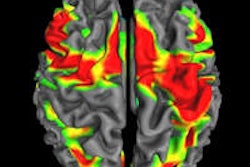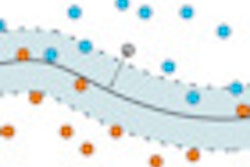Using advanced MRI and an artificial intelligence technique, researchers in Geneva, Switzerland, have identified a method that may help identify which individuals with mild cognitive impairment (MCI) will continue to decline, according to a study published online and in the December issue of Radiology.
Lead researcher Sven Haller, MD, a radiologist at University Hospitals Geneva, and colleagues used two novel techniques to image the brains of 35 control participants (mean age, 63.7 years) and 69 patients with MCI (mean age, 65 years; 38 women, 31 men).
Patients were diagnosed with MCI based on a battery of neuropsychological tests, which were repeated on 67 of the patients one year later to determine whether their disease was stable (40 patients) or progressive (27 patients).
Using an advanced technique called susceptibility-weighted MRI, the researchers were able to generate scans with greater detail of the many blood vessels in the brain, including the presence of tiny leaks called microhemorrhages or microbleeds.
The researchers noted that the number of cerebral microbleeds was significantly higher in the individuals with mild cognitive impairment than in those in the control group. MRI scans revealed microbleeds in 33% of individuals with stable MCI and in 54% of patients with progressive MCI. Only 14% of the control participants had microbleeds.
Susceptibility-weighted MRI scans also revealed that compared to the control participants, individuals with MCI had significantly increased iron concentration in certain areas deep within the structure of the brain, along with reduced levels of iron in other areas.
Haller and colleagues also analyzed the MRI data with support vector machines (SVM), an artificial intelligence technique that uses algorithms to identify patterns within a group and create classifications. SVM analysis of baseline MRI data acquired at the initial exam distinguished patients with progressive MCI from those with stable MCI with 85% accuracy.
The goal of the work is to identify biomarkers of mild cognitive impairment that will help diagnose individual patients at risk for further decline, Haller said, adding that using SVM to analyze iron deposits in the brain may be such a biomarker.
By Wayne Forrest
AuntMinnie.com staff writer
October 5, 2010
Related Reading
MRI beats FDG-PET for early Alzheimer's detection, August 27, 2010
FDG-PET and memory tests best predict Alzheimer's, June 30, 2010
MRI finds genetic link in Alzheimer's disease, June 14, 2010
PET can help clarify dementia diagnoses, May 3, 2010
MRI hippocampal measurement doesn't predict cognitive decline, April 26, 2010
Copyright © 2010 AuntMinnie.com



















